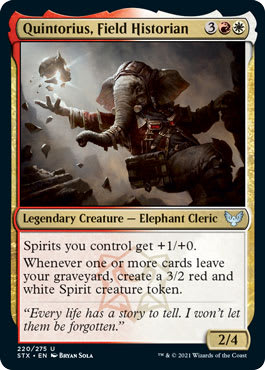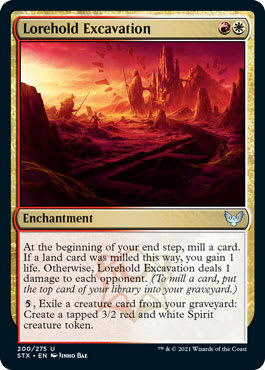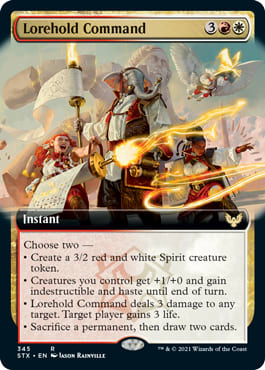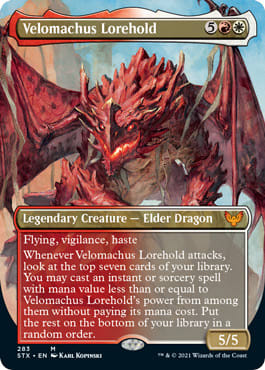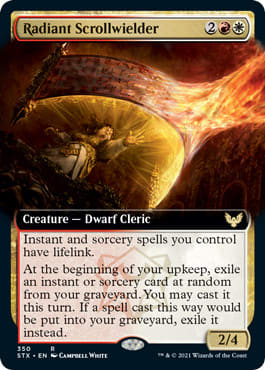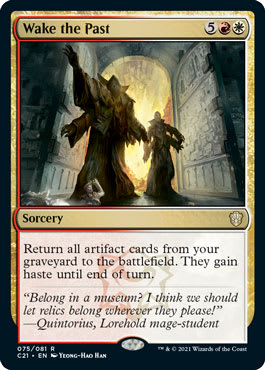One of the best parts of Magic - a game predicated on variance - is that there are certain things that are always true and have been for 27 years. Island is the best card in the game. Flyers are good in Limited. Red's cards create chaos, while Black's excel at removing creatures. And so on. We learned what the colors do, and even if you take a long break from the game, those colors are still going to do what you remember them doing. It helps the game to feel familiar, even as the individual cards and decks change over the years.
Back in 2005, Wizards recognized this as a strength of the game, and pushed it a step further with the Guild system in Ravnica: City of Guilds. Black-Green always did graveyard stuff, so Golgari's keyword was dredge (as seen in Golgari Grave-Troll). Izzet was all about spellcasting, while Azorius was taxes and control elements.
We seem to visit Ravnica every few years (and I enjoy it every time), but even when we're not talking about the guilds, we're talking about the guilds. Whether it's specifically the Izzet guild or not, Blue-Red is all about casting spells, and that's by and large the identity the color pair has formed - the Blue-Red theme in Eventide looks mighty like Izzet. Blue and Red cast tricky spells like Inside Out - that's just what it does, just like Boros is all about attacking.
Lorehold Me Close
That's where Lorehold comes in. We saw Quintorius, Field Historian and just like that, everything changed. We never knew what we were missing until ol' Quint was joined by Velomachus Lorehold showing us the new side of Red-White.
Those are no Boros Elite - there's not a Boros Recruit in sight. Instead, we have the words I'd expect to see from almost any color combination before Boros...Red-White.
Whenever one or more cards leave your graveyard... wait, that's not Witherbloom? Reconstruct History does what?!?
But it works. Both Red and White have graveyard interactions like Faithless Looting and Resurrection. Venerable Warsinger feels like it fits, even though it's not at all what we would expect from Boros.
But this isn't Boros - it's Lorehold. And that's a triumph of modern design.
Think about it - Magic has been putting out multicolored cards since Legends in 1994. That's almost 30 years, and yet in 2021 with Strixhaven Wizards did what we least expect: surprised us (or me, at least). Lorehold feels Red-White, and yet it also feels completely distinct from Boros. While they didn't find the same success in every color pair (Witherbloom feels to me like your typical Golgari fare), the introduction of the university of Strixhaven and its five colleges gave Wizards the opportunity to reimagine what Red-White could be, and now we enter a bold future where upcoming products have two distinct Red-White options to choose from. Rather than getting the 87th iteration on Boros-flavored ATTACK! and EQUIPMENT! cards like Wyleth, Soul of Steel, this color combination can now lean into its Lorehold side and give us something else entirely, and cards like Alibou, Ancient Witness give us some fun new build-arounds.
On some level, this is just about branding - Lorehold itself was never necessary for them to explore new design space in this area, but just like Ravnica is incredibly popular because it encourages people to identify with a guild, Strixhaven and Lorehold have opened up a whole new avenue for people who like the colors but don't want to spend their Commander nights attacking with 2/2s or running into Vandalblasts with their Boros equipment deck.
Exceeding Expectations
That's why I call it a design breakthrough - it's not just about Strixhaven and Commander 2021, it's about the identity (or identities) of Red-White as a color pair. As problematic as balancing has been for Wizards in recent years, I have to say they continue to raise the bar on what is possible design-wise. Companions were a leap I hadn't even considered possible, and after some balance tweaks they've found a great niche in Magic while surprising us in their ingenuity. Sunforger fans could not be happier.
We've seen this same kind of breakthrough with Red as a color. The "impulsive" drawing of cards like Light Up the Stage and Valakut Exploration gave Red access to card draw in a way that felt Red, while all the fight effects in Green gave the color removal options that made sense in its color pie.
I'm not here to rehash the "White is bad in Commander" argument - Wizards has acknowledged that they're working on it - but it certainly helps that suddenly Red-White has an entire plethora of deck-building options that weren't as pushed previously. Combined with the "mana catchup" effects we're seeing like Archaeomancer's Map and Monologue Tax, it's not hard to see a new class of decks popping up in Commander moving forward.
The Wheels are Turning
I've been playing Magic for nearly 15 years. In that time, I've played at the highest competitive levels, slung 65-card casual decks and played a lot of Commander along the way. By virtue of both work and hobby, I consume more Magic content than most people ever will. So, when any "new" thing happens, it tends to slide off me and I go back to grinding Kaldheim drafts on Arena. Which is one of the reasons I find Lorehold so compelling; it's not about any individual card, it's about the ability to innovate and surprise in an area so thoroughly explored. It's a triumph for the Design team, and I can't wait to get my hands on the cards.
To that end, I want to share one of my first stabs at building around the new themes. Say hello to Alibou, Ancient Witness!
Alibou EDH | Commander | Corbin Hosler
- Commander (1)
- 1 Alibou, Ancient Witness
- Creatures (30)
- 1 Bladegriff Prototype
- 1 Bronze Guardian
- 1 Burnished Hart
- 1 Combustible Gearhulk
- 1 Digsite Engineer
- 1 Dockside Extortionist
- 1 Ethersworn Canonist
- 1 Foundry Inspector
- 1 Goblin Welder
- 1 Goldspan Dragon
- 1 Hangarback Walker
- 1 Kuldotha Forgemaster
- 1 Lodestone Golem
- 1 Loyal Apprentice
- 1 Metallurgeon
- 1 Myr Battlesphere
- 1 Myr Retriever
- 1 Myrsmith
- 1 Pia and Kiran Nalaar
- 1 Pia Nalaar
- 1 Precursor Golem
- 1 Ruin Grinder
- 1 Scrap Trawler
- 1 Solemn Simulacrum
- 1 Steel Hellkite
- 1 Steel Overseer
- 1 Thopter Engineer
- 1 Toggo, Goblin Weaponsmith
- 1 Walking Ballista
- 1 Wurmcoil Engine
- Planeswalkers (2)
- 1 Daretti, Scrap Savant
- 1 Karn, Scion of Urza
- Instants (4)
- 1 Dispatch
- 1 Generous Gift
- 1 Swords to Plowshares
- 1 Valakut Awakening
- Sorceries (4)
- 1 Rip Apart
- 1 Saheeli's Directive
- 1 Vandalblast
- 1 Wake the Past
- Enchantments (1)
- 1 Ghirapur Aether Grid
- Artifacts (24)
- 1 Arcane Signet
- 1 Bloodforged Battle-Axe
- 1 Boros Signet
- 1 Cursed Mirror
- 1 Fellwar Stone
- 1 Fire Diamond
- 1 Forsaken Monument
- 1 Ingenuity Engine
- 1 Idol of Oblivion
- 1 Marble Diamond
- 1 Mimic Vat
- 1 Mind Stone
- 1 Mirrorworks
- 1 Mycosynth Lattice
- 1 Mystic Forge
- 1 Replicating Ring
- 1 Retrofitter Foundry
- 1 Skullclamp
- 1 Sol Ring
- 1 Talisman of Conviction
- 1 Thran Dynamo
- 1 Treasure Map
- 1 Embercleave
- 1 Helm of the Host
- Lands (33)
- 5 Plains
- 6 Mountain
- 1 Ancient Den
- 1 Arid Mesa
- 1 Battlefield Forge
- 1 Blinkmoth Nexus
- 1 Bonders' Enclave
- 1 Boros Garrison
- 1 Buried Ruin
- 1 Clifftop Retreat
- 1 Command Beacon
- 1 Command Tower
- 1 Darksteel Citadel
- 1 Drownyard Temple
- 1 Great Furnace
- 1 Inkmoth Nexus
- 1 Inventors' Fair
- 1 Mishra's Factory
- 1 Needleverge Pathway
- 1 Rugged Prairie
- 1 Sacred Foundry
- 1 Spectator Seating
- 1 Stone Quarry
- 1 Sunbaked Canyon














